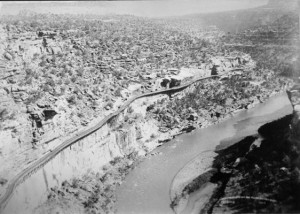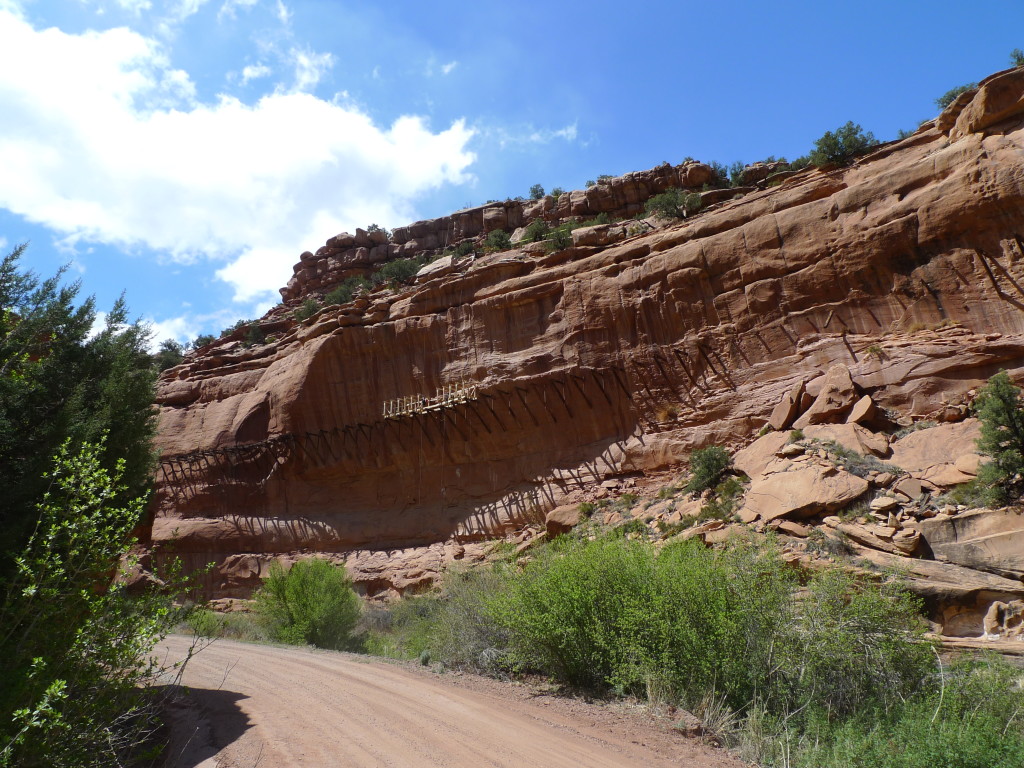Story
Investigating an Engineering Mystery: Western Colorado’s Hanging Flume
In Montrose County, Colorado, an incredible feat of mining engineering clings to sheer canyon walls above the Dolores and San Miguel rivers. Built in the 1880s, the Hanging Flume carried the water used to extract the fine gold from placer deposits. The flume has captivated historians and tourists alike, but no one has been able to determine exactly how it was built in just a few years in such a remote and inhospitable location.
Going to Great Lengths for Gold
The Colorado Gold Rush began in 1858, but it would be another 30 years before Ute lands in the San Juan Mountains were opened to mineral exploitation. In 1887 the Montrose Placer Mining Company purchased several claims along the Dolores River and quickly commissioned the construction of a ten-mile long flume to carry water to the gold deposits. The structure was completed in two years, by perhaps two dozen men hauling hundreds of thousands of board feet of lumber over wagon trails and building forges on-site to shape the iron rods that pin the flume to the canyon walls.
Upon the flume’s completion, the Montrose Placer Mining Company began “washing” the deposits using high-pressure hydraulic mining techniques developed earlier in the century during the California Gold Rush. But the low yield could not compensate for the huge expense of building the flume, and the company folded. A nearby ranch soon repurposed the flume for irrigation, and later, homesteaders and miners scavenged lumber to build homes and other structures. The flume box is all but gone, but the heavy timber bents that supported it are still visible, pinned to the canyon walls.
Flume Fever
Locals and tourists alike are enthralled by the flume, which can be seen from overlooks along the Unaweep-Tabeguache Scenic and Historic Byway. Historians, engineers, and scientists have caught “Flume Fever,” too. The flume represents the great lengths to which individuals went to develop Colorado’s mining resources, and it is a significant engineering achievement. The Hanging Flume is the only structure of its kind in the United States that survives relatively intact. It is listed on the State and National Registers of Historic Places, and it was named on the World Monuments Fund's 2006 Most Endangered Sites list. In 2012, a team of experts reconstructed a 48-foot section of the long-vanished flume box, giving visitors an idea of how the flume would have looked when it was completed.
Part of the flume’s appeal is the mystery of how it was built. How did a small group of laborers working in a remote landscape build 30 linear feet of flume per day? How did they drill the thousands of holes into solid rock required to secure the flume to the cliff face? Each timber bent is unique, essentially custom-built in order to accommodate the changing geometry of the cliff face. How did the workers in the canyon, possibly suspended in bosun’s chairs, communicate with the blacksmiths on the rim in order to shape the iron for a perfect fit?
These and other questions remain unanswered. Several expeditions to document the flume have yielded tantalizing clues. Seven distinct framing methods have been identified for the timber and iron supports, but with only about ten percent of the flume documented, there could be more clues waiting to be discovered.
Flume Fever from Mara Ferris on Vimeo.
Solving the Mystery
The Interpretive Association of Western Colorado (IAWC) is raising funds to send the original project team of historians, wood scientists, engineers and difficult access experts to investigate remaining sections of the flume. Sun, wind and water continue to degrade the flume timbers, and the team hopes to gather more information before key sections of the structure are lost forever. The IAWC is accepting contributions for this next phase of investigation.
Learn more about the Hanging Flume from the Unaweep-Tabeguache Scenic and Historic Byway and the Interpretive Association of Western Colorado, or plan a visit to the flume itself!
But be careful -- you just might catch Flume Fever!


